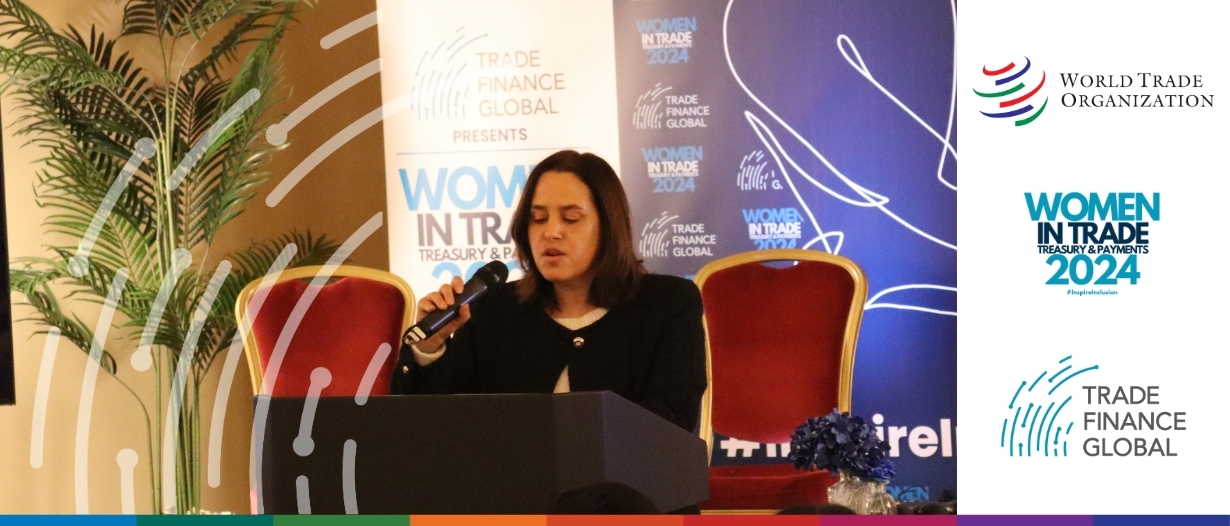Estimated reading time: 7 minutes
Trade Finance Global hosted our annual Women in Trade, Treasury & Payments event at the Lansdowne Club in London. Over 60 female leaders in the industry came together to celebrate the achievements of all women across the the industry and world.
At the event, Trade Finance Global had the honour to host Deputy Director General Johanna Hill, who gave a keynote address at the evening event.
Good evening, ladies and gentlemen, dear friends.
Let me start by thanking Trade Finance Global, as well as its partners, the Asian Development Bank and the International Finance Corporation, for organising this event. The event that highlights the value of women in the global economy and the importance of economic inclusion for women. It is an honour to be here with you tonight, especially having heard during the roundtables your inspiring stories and contributions.
Given my role at the WTO, it should not come as a surprise that trade will take centre stage in my remarks. Also, trade is a valuable tool that can promote social and economic inclusion of women.
Firms that trade employ more women. According to a joint study by the WTO and the World Bank, women comprise 33% of the workforce of export firms. This is more compared with 24% of non-exporting firms.
Trade firms also offer better remuneration to women. Those working in export-oriented companies collect a 10-20% wage premium over the average wage in Western Europe. In Sub-Saharan Africa, this figure is as high as 34%. Trade firms are also more likely to employ women formally, providing economic stability for their families and communities.
As you can see, trade helps boost the economic inclusion of women. However, the international trading system is undergoing significant changes. So we need to ensure that its future holds the promise of a better life, in particular for women.
At the WTO, we believe that the future of trade, in addition to being green, is inclusive and digital. I personally think that it will also be services trade. I would like this to be the focus of my message to you today. I would like to show you that digital trade and trade-in services are particularly powerful tools of inclusion for women.
Let me start with the former and take you on a journey to the tropical island of Bali. This famous island that many know from Eat, Pray and Love, is also well known for its cocoa and coffee.
Cocoa and coffee farmers are struggling financially despite the high prices of the final product. According to the Fairtrade Foundation, cocoa farmers earn on average just 6% of the final value of a chocolate bar.
But today, thanks to blockchain-based technology, female farmers in Bali can connect to new markets and directly access financial services. They can also trade directly with exporters and producers, ensuring a fair price for their product.
Their story is not an isolated case. According to Etsy, eight in ten sellers on the platform are women. For Shopify, this number is just above 50%. So while the exact figures differ depending on the platform, these and other examples suggest that women entrepreneurs are relatively more present online than offline.
Why is it so? Are we particularly skilled in e-commerce?
The answer is much simpler. Digital trade can provide women with increased access to global markets and flexible work opportunities. It can remove traditional market entry barriers, including those related to time and mobility constraints. In other words, digital trade is particularly helpful in overcoming limitations associated with gender bias.
Digital trade can also make available to women finance mechanisms that bypass the traditional barriers to capital. Technology-enabled digital lending, working capital and crowdfunding platforms are examples of how digital trade-in services can offer an alternative means to address women’s financial constraints.
This brings me to my second point, which is trade-in services. According to a recent study done by the WTO and the World Bank, the global services sector accounts for two-thirds of the worldwide output and half of employment. This is more than industry and agriculture combined.
In 2021, three in five women were employed in services. Women-led firms have also more success in the services sector, especially those delivered remotely or over digital platforms. This suggests that some gender-specific barriers to female entrepreneurship may prove less onerous than in industry.
But while trade in services can provide more and better economic opportunities for women, it is not bias-free. A recent WTO report shows that trade costs are higher in more female labour-intensive services.
This includes costs related to regulatory and trade policies. This suggests that improving the regulatory climate for trade in services can help reduce the female wage gap.
The WTO Members are working on this, including at the recent Ministerial Conference. As the negotiations started in Abu Dhabi, new disciplines on good regulatory practice for services trade entered into force.
These rules are estimated to lower service trade costs by over $125 billion worldwide. It is also the first time that a WTO-negotiated text contains a provision on non‑discrimination between men and women. It aims at ensuring non-discrimination in authorisation processes, thereby supporting women’s participation in services trade.
An important aspect of fostering women’s economic participation is access to finance. Research indicates that firms owned or led by women are often small businesses. They are more dependent on trade finance, but their requests face a higher rejection rate than men-owned businesses.
Model simulations conducted jointly by the WTO and the International Finance Corporation suggest that improving access to trade finance could increase West African countries’ trade by as much as 16%, or $26 billion. Trade in financial services, especially those delivered through digital means, can play a major role here.
This is why WTO Members launched a MC13 a policy tool mapping current governmental initiatives that support access to finance for women. This compendium could be used as a valuable source of inspiration for policymakers.
It could be particularly helpful in providing alternative means of addressing the financial constraints of female entrepreneurs.
Since we touched upon specific projects supporting women’s economic inclusion, let me say a few words about other such initiatives at the WTO.
Still, on the subject of access to finance, the WTO and the International Trade Centre launched jointly at MC13 a $50 million fund to support women exporters. The Women Exporters in the Digital Economy (WEIDE) will provide women-led businesses in developing economies and LDCs with the resources needed to adopt digital technologies.
Another event held during the Ministerial Conference showcased the potential of digital trade for growing economies and improving livelihoods in Africa. The joint project of the WTO and the World Bank aims at analysing the gaps in digital trade frameworks and addressing them through capacity building and infrastructure support.
Digital trade could prove particularly beneficial for MSMEs, especially those run by women. According to the WTO and the World Bank, three in every four firms trading exclusively through e-commerce in Africa are owned by women.
Since 2020, the Informal Working Group on Trade and Gender has sought to intensify efforts to increase women’s participation in global trade. The WTO Secretariat actively supports Members in this work through a number of initiatives.
We launched a Gender Research Hub to inform discussions across WTO bodies with research findings. Last year, the WTO published a report on Making Trade Work for Women. It sets out the key conclusions of the first World Trade Congress on Gender, held in 2022.
The WTO also offers governmental officials training on trade and gender issues. All of this is to help Members integrate gender into their trade policies.
If we want to close, or at least narrow the gender gap in trade we need to intensify efforts across the board. But if we want to be effective, we must focus on improving the regulatory framework for digital trade and trade in services. Because of this, the future of trade and the future of women in trade.

































